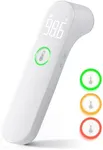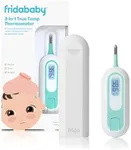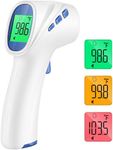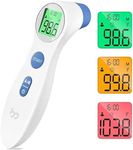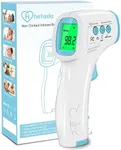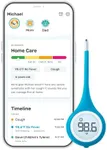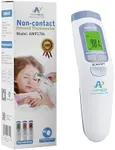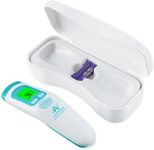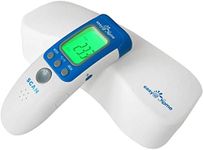Buying Guide for the Best Thermometer For Kids
Choosing the right thermometer for kids is crucial for accurately monitoring their health. Kids can be more sensitive to temperature changes, and having a reliable thermometer can help you respond quickly to any signs of illness. When selecting a thermometer, consider the ease of use, accuracy, and comfort for your child. Here are some key specifications to help you make an informed decision.Type of ThermometerThere are several types of thermometers, including digital, ear (tympanic), forehead (temporal artery), and rectal thermometers. Digital thermometers are versatile and can be used orally, rectally, or under the arm. Ear thermometers are quick and easy but may not be suitable for very young children. Forehead thermometers are non-invasive and easy to use, making them great for kids. Rectal thermometers are the most accurate for infants but can be uncomfortable. Choose the type based on your child's age and comfort level.
AccuracyAccuracy is crucial when it comes to measuring a child's temperature. Digital and rectal thermometers are generally the most accurate. Ear and forehead thermometers can also be accurate but may require proper technique. Look for thermometers that have been clinically tested and approved for accuracy. If your child is very young or has a medical condition, prioritize accuracy to ensure you get reliable readings.
Ease of UseEase of use is important, especially when dealing with a sick or fussy child. Digital thermometers are straightforward and often come with features like backlit displays and fever alerts. Ear and forehead thermometers are quick and non-invasive, making them easier to use on a squirmy child. Consider how easy it is to clean and maintain the thermometer as well. Choose a thermometer that you can use quickly and efficiently, especially during nighttime checks.
Reading SpeedReading speed refers to how quickly the thermometer can provide a temperature reading. Faster readings are generally better for kids, as they are less likely to stay still for long periods. Digital thermometers can take anywhere from a few seconds to a minute, while ear and forehead thermometers usually provide readings in a few seconds. If your child is very active or impatient, opt for a thermometer with a faster reading speed.
Memory FunctionSome thermometers come with a memory function that stores previous temperature readings. This can be useful for tracking your child's fever over time. The number of readings stored can vary, with some thermometers storing up to 20 readings. If you need to monitor your child's temperature closely, a thermometer with a memory function can be very helpful. Choose one that stores enough readings to meet your needs.
Display and AlertsA clear display and alert system can make it easier to read and interpret temperature readings. Look for thermometers with large, backlit displays that are easy to read in low light. Some thermometers also have color-coded alerts or sound alarms to indicate a fever. These features can help you quickly understand your child's condition without having to interpret the numbers. Choose a thermometer with a display and alert system that you find easy to use.
Age AppropriatenessDifferent thermometers are suitable for different age groups. Rectal thermometers are recommended for infants under three months due to their accuracy. Ear thermometers are generally suitable for children over six months. Forehead thermometers can be used for all ages but may be less accurate for infants. Digital thermometers are versatile and can be used for all age groups. Consider your child's age when choosing a thermometer to ensure it is appropriate and comfortable for them.



